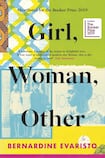
Bernardine Evaristo’s eighth work of fiction, which has been shortlisted for the Booker Prize, is one of those books that makes the reader ask “Where have you been all my life?” and rush out for the author’s backlist. Perhaps coming to a writer afresh when their talent is fully formed makes the effect all the more dramatic – if so, then the new readership Evaristo will justifiably gain from her shortlisting will be thrilled.
Evaristo sets out her stall from the title: this is a populous, expansive, inclusive book: everyone is welcome. The structure is to tell the stories of 12 (mostly black) women in Britain over the last century, each in her own chapter but with connections and crossovers throughout.
To describe the stories of all 12 would take up this entire review, but some can be highlighted as central. Amma is a middle-aged playwright and theatre director, firmly in the establishment despite her imposter syndrome (“what if the preview audiences who gave standing ovations were just being kind?”) which derives from her outsider background: working-class, black, lesbian.
Amma has a 19-year-old daughter (through sperm donation by a gay friend), Yazz, who gets a chapter of her own. Once an iconoclast herself, Amma’s own privileges are challenged by Yazz, responding to her mother’s complaints about wine bars and gastropubs that Amma herself was “part of the gentrification of Brixton years ago”. The counterpoint between different characters’ accounts of the same experiences is one of the satisfying pleasures of the book.
Controlling abuser
Amma has two lifelong friends: the first, Dominique, she met at a film audition: “both were disillusioned at being put up for parts such as a slave, servant, prostitute, nanny or crim . . . and still not getting the job”. Dominique’s chapter is perhaps the book’s strongest standalone story, as she falls in love with Nzinga, a “teetotal, vegan, non-smoking, radical separatist lesbian housebuilder” who turns out to be a controlling abuser.
Amma’s other friend, Shirley, is now a teacher, and she and two of her former pupils all get chapters of their own. Carole and LaTisha have gone very different ways since their schooldays: Carole, helped by her ambitious mother Bummi (who also gets her own story) and Shirley as her teacher, won a place at Oxford University where she studied mathematics, and now works in banking in the City of London, where “she’s used to clients and new colleagues looking past her to the person they are clearly expecting to meet”. Her employer is sponsoring Amma’s new play, The Last Amazon of Dahomey, at the National Theatre. LaTisha, meanwhile, had a tougher upbringing, and is a single parent to three children with three fathers, but is making her own mark as a retail supervisor.
Shirley in her job shares Carole’s fear that she needs to be representative of her race in a way no white person ever feels. Like her childhood friend Amma, she seeks to survive in a society not built in her image, but she seeks to do so by fitting in, whereas Amma wants – or wanted – to smash the system.
Characters and humour
Evaristo herself treads a line between Shirley and Amma: she welcomes the reader and provides strong stories, appealing characters and lots of humour. But she is also an iconoclast, challenging our comfortable preconceptions on race and politics, and doing it in a narratively innovative way.
Every character’s story is told in floating sentences and fragments on the page, with only one full stop at the end of each chapter. The effect is more Solar Bones than Ducks, Newburyport – the book looks like prose poetry but reads as normal narrative, and the device is effective in evoking diverse characters’ thoughts. It also provides a versatile way for a busy, noisy scene to settle down to silence, and a flexible rhythm for jokes, shocks and other conclusions:
she tried boys a couple of times
they enjoyed it
she endured it
If there are weak spots in Girl, Woman, Other, they come at the end: it’s not clear we need the scene at the afterparty for Amma’s play – where many of the characters are brought together – given the connections and interplay we’ve already seen between them. And there is a coda with a dramatic revelation for Penelope, the only white woman whose story we hear, which sets a different tone. But these do not detract from the great pleasure to be had from this warm, seductive and politically engaged book.









